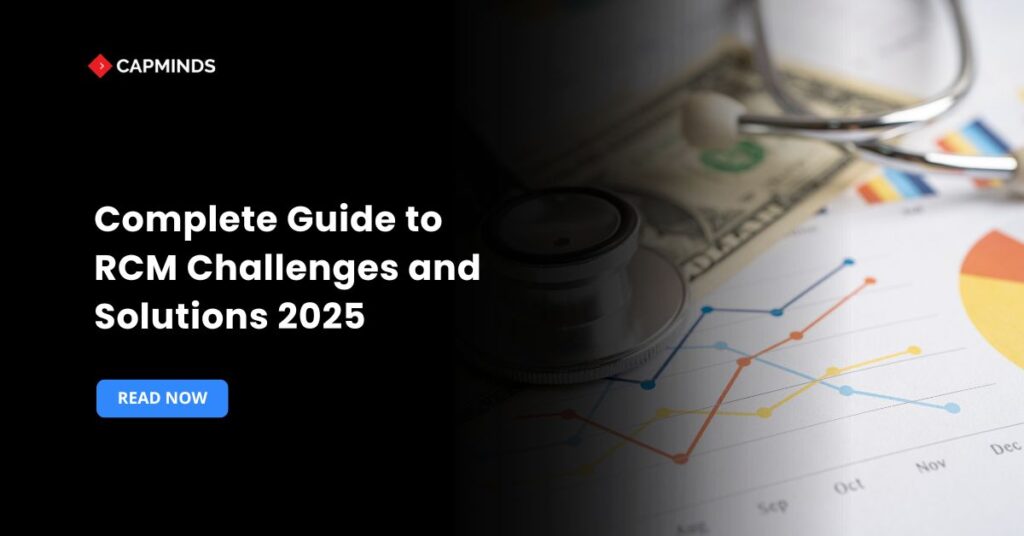Complete Guide to RCM Challenges and Solutions 2025
Revenue cycle management is the economic engine that keeps hospitals, clinics, and physician practices running. It encompasses everything from verifying insurance eligibility before an appointment to coding, billing, collections, and data management after a patient leaves.
In 2025, the stakes are higher than ever. Some of the healthcare RCM issues are labor shortages, high denial rates, cyber-attacks, and new regulations requiring high compliance.
This guide provides a comprehensive view of RCM challenges in 2025, effective solutions to overcome them, and to improve your practice’s revenue cycle with outsourcing RCM services.
RCM Challenges and Their Solutions in Healthcare
1. High Claim Denials
Challenge
Claim denials have always been a pain point in healthcare, but in 2025, this has become a crisis. Payer policies have never been as complicated and have not been standardized across various insurers.
The outcome is a high denial rate, and in many cases, as a result of avoidable mistakes, like false patient data, coding errors, or a missed effort to obtain prior authorization.
The Impact
This directly affects the finances of your organization. It decreases cash flow, higher administrative expenses due to claim appeals, and a high loss of possible revenue.
Solution
The historical denial data can be studied by the AI algorithm to determine the patterns and predict which claims are most likely to be denied.
Automated claim scrubbing, pre-submission checks, and real-time eligibility checks can be automated using RPA to ensure that a clean claim is sent out the first time.
With these tools in place, you can increase your first-pass clean claim rate by a large margin and redirect the efforts of your team towards preventing denials instead of responding to them.
2. Patient Financial Responsibility
Challenge
The rise of high-deductible health plans has put an increasing financial burden directly on the patient. In most of the practices, patient collections have become one of the most important components of their overall income.
Opaque billing statements tend to confuse patients who do not have easy payment methods, thus causing delayed payments or, in most instances, no payment at all.
The Impact
This difficulty poses a significant accounts receivable backlog, higher collection expenses, and most importantly, a poor patient experience resulting in poor reputation and loyalty.
A patient will leave the whole experience of the care received and may not be willing to come back or refer to other patients due to frustrated billing payments.
Solution
Develop a Patient-Centric financial experience. Think of the patient as a consumer of money rather than as a receiver of a bill. There are a number of strategies that offer financial transparency in advance through the use of pre-service financial conversations and proper cost estimates.
Providing a smooth online experience through straightforward and understandable billing documents and various online payment methods, such as online portals, text-to-pay, and mobile applications.
Offer alternative payment schemes that would enable the patients to pay high balances in small and manageable payments.
3. The Regulatory and Compliance
Challenge
A significant challenge is to remain in compliance with ever-evolving healthcare laws. The new rules and more enforcement power over the No Surprises Act will be a significant concern in 2025.
The frequent changes are made to the Physician Fee Schedule and new payer transparency standards. The number of compliance changes is so high that it is hardly possible to comply manually.
The Impact
If not able to comply with them, the consequences might be rejection of claims, expensive audits, and imposition of financial fines.
The resources and time spent on the manual tracking and effecting changes in regulations also drag your team away from value-added activities.
Solution
Use Advanced data analytics and integrated systems. Work beyond manual updates and get into an RCM platform that has built-in and automated compliance devices.
These systems are also updated on a regular basis by vendors about the existing changes in codes and their payer specifications, and federal regulations.
Your team can also conduct real-time audits with advanced data analytics to identify potential compliance issues before they become a problem.
Related: 9 Revenue Cycle Management Steps That Every Practice Must Know
4. Cybersecurity Threats
Challenge
Healthcare information is the major target for cybercriminals as it can be bought on the black market. RCM systems, and especially those with large amounts of sensitive patient and financial data, are highly susceptible.
The number of processes being digital and cloud-based is large; hence, the attack surface widens, and data security is becoming a difficult and persistent issue.
The Impact
Data breach is not only an IT issue, but a revenue crisis. The reputational and financial losses of a cyberattack are harmful. It requires months before the recovery process can be done on it, and this interferes with the operations and postpones billing.
The Solution
Implement new cybersecurity solutions and data management. A multi-layered approach to security is the answer. Install robust and modern RCM systems that will be more encrypted, have MFA, and real-time threat detection.
It must also be ensured that third-party vendors and partners are all aligned with the optimal security standards, such as the HITRUST and Zero Trust models.
Organization leaders must participate in cybersecurity activities with RCM experts and must also have employees undergo periodic training on how to identify and prevent security threats.
5. The Staffing and Skills Gap
Challenge
The healthcare sector is still facing a massive problem of labor shortage, and RCM roles are no exception. The traditional method of billing and coding is very labor-intensive, yet locating experienced and well-trained staff has become harder. The results in a shortage leading to overworking, more errors, and dependence on outdated, manual processes.
The Impact
A shortage in staffing will affect the entire revenue cycle. It causes a decrease in efficiency, a decline in the speed of claims processing, and increases the cost-per-claim.
Administrative burden among staff leads to high turnover and creates a vicious cycle of knowledge loss and inefficiency.
Solution
Invest in outsourcing RCM billing specialists. Although technology might be used to automate tasks, your staff is the most valuable thing you have.
By partnering with a specialized RCM firm, you will be able to access their resources and advanced technology without necessarily having to acquire, educate, and sustain employees. This reduces the administrative load and provides access to scalable resources.
Transform Your Revenue Cycle with CapMinds RCM Services
At CapMinds, we understand that navigating claim denials, compliance, cybersecurity, and staffing shortages is overwhelming for healthcare organizations. That’s why we deliver end-to-end RCM services designed to secure your financial health and reduce administrative burden.
Our RCM medical billing services combine expert billing teams with cutting-edge technology to help you achieve a faster, cleaner, and more resilient revenue cycle.
With CapMinds, you can:
- Optimize RCM workflows through AI-driven claim scrubbing and denial management.
- Boost collections with patient-centric billing and multiple payment options.
- Stay compliant with evolving payer rules and federal regulations.
- Strengthen security through advanced data protection frameworks.
- Scale effortlessly by outsourcing RCM services to our dedicated specialists.
Partner with CapMinds to turn your RCM challenges into opportunities. Let us streamline your billing, protect your revenue, and empower your staff to focus on what matters most, delivering exceptional patient care.




